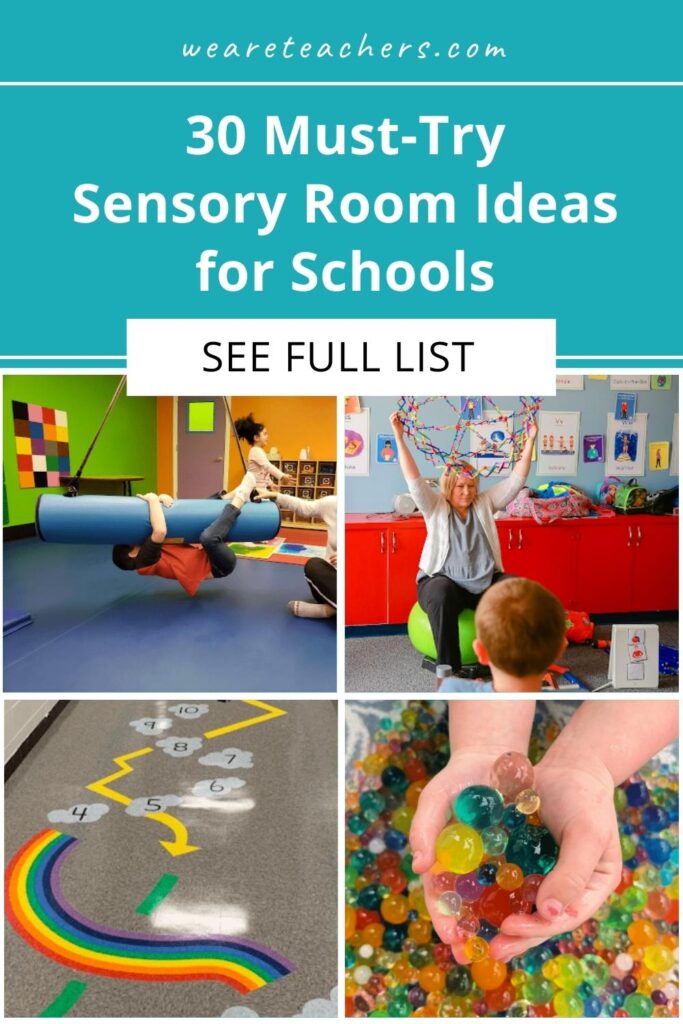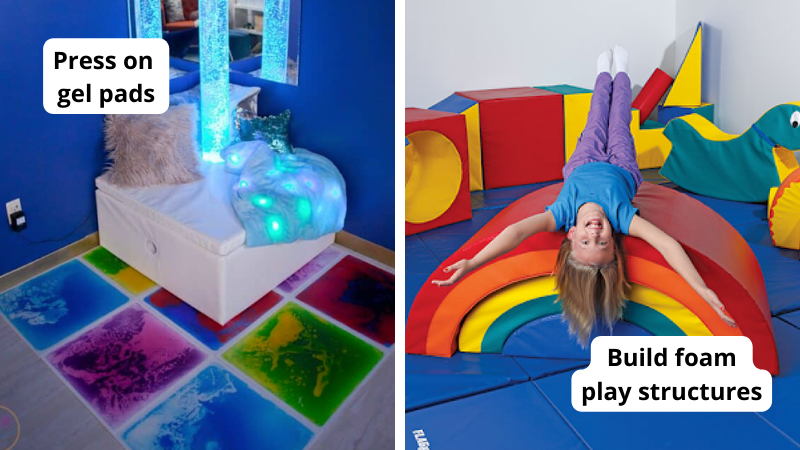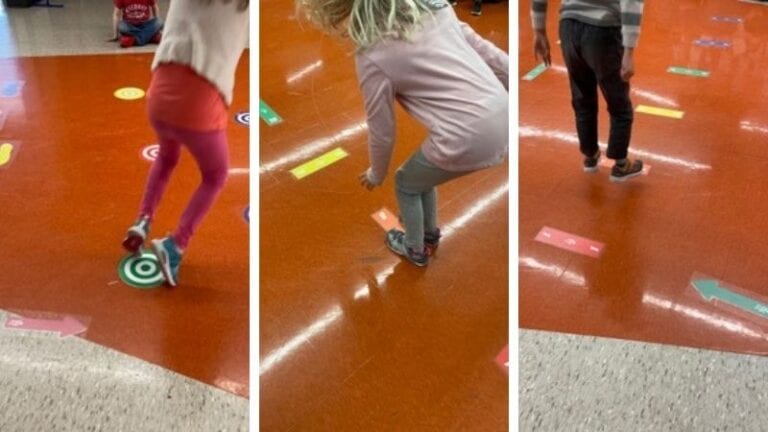While many educators report that student behavior issues are on the rise, consider that some of these students may be seeking a unique sensory need. Sensory rooms in a school setting are intended to be a therapeutic place students can visit to calm, regroup, and refocus themselves. Students can visit for a few minutes when needed or have scheduled time in the sensory room to explore, imagine, and burn off some curious energy. Many schools that have created a sensory room (or a sensory space) have noticed a dramatic decrease in behavior referrals. Ready to create one at your school? These must-try sensory room ideas will make your space the most efficient (and coolest) place in your school!
By the way, we know sensory room equipment costs add up, so consider writing a grant to your local school district, community organizations, or online support sites to get help with funding your sensory room.
1. Go for a swing
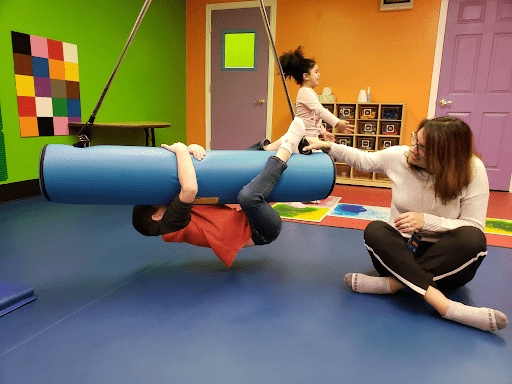
Swinging is a calming motion for children. When a child is anxious or overly stimulated, the swinging motion can release endorphins in the body, allowing children to get calm and feel a sense of comfort or relief. While it may seem like a child is just running around the general education classroom or swaying side-to-side in a chair, they could be expressing a physical need. Take them into the sensory room to find a sense of calm on the swing.
Buy it: Swinging Monkey Giant Mat Platform Swing at Amazon; Outsunny Rectangular Tree Swing at Oriental Trading
Image: Li Herald
2. Regroup in a comfort chair
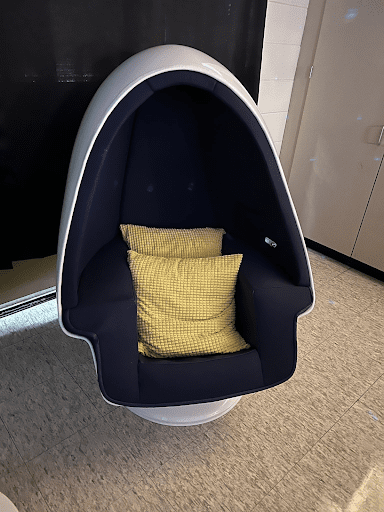
Though egg chairs can be quite pricey, there are plenty of other cost-efficient alternatives that can serve your students’ needs in your Sensory Room. When a child is expressing sensory overload or is in need of a sensory outlet, sometimes seclusion can be beneficial. Students can grab a book, use a fidget, or take a short rest in the comforting chair to regroup before they continue with their day.
Buy it: Hanging Basket Chair at Amazon; Mainstays Faux Fur Saucer Chair at Walmart
Image: Diaka Melendez Twitter
3. Walk, crawl, or lie on a sensory mat
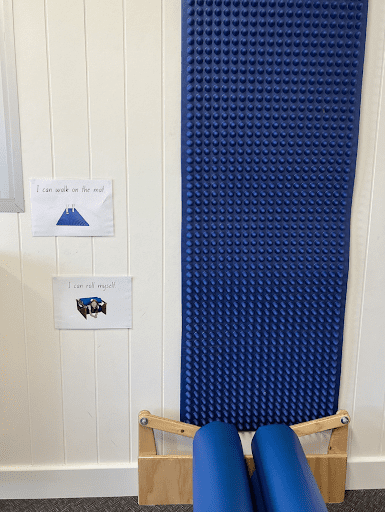
Sensory mats can be used in a variety of different ways. Students can push on the mat to relieve emotions of anger or distress. They can walk or crawl on the mat to embrace the tactile comfort that can be associated with different surfaces. Students can lie or roll on the mat to enjoy the pressure the mat can bring to their bodies.
Buy it: Sensory Mat Module Set of Massage Mats at Amazon
Image: Sunflower Speech Twitter
4. Sway in a hammock
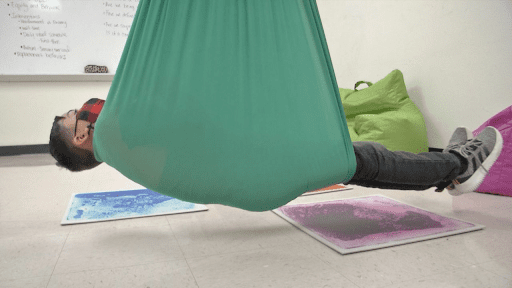
Looking for more sensory room ideas for kids who love to swing? Hammocks are another great tool to include in the sensory room at your school. Students can sway side-to-side to relax, roll themselves up to feel comfort, or lie in the hammock to calm themselves and their emotions. Hammocks are a cost-efficient tool to include in your room. (Tip: Consider shopping the spring/summer or other seasonal sales for an affordable find!)
Buy it: Grassman Hanging Hammock at Amazon; Best Choice Brazilian Style Cotton Hammock at Walmart
Image: Spectrum News 1
5. Bounce on a breathing ball

For some students, the chaos of the school day can be a lot to handle. We know that focused breathing helps calm the nervous system and is a great tool to help those who are anxious, upset, or angry. Simply telling students to “just breathe” is not enough. Consider having visuals or tangibles, like a breathing ball, in your sensory room to help students while they breathe and relax.
Buy it: Expandable Breathing Colorful Ball at Amazon
Image: Hundred
6. Gaze at a lava lamp
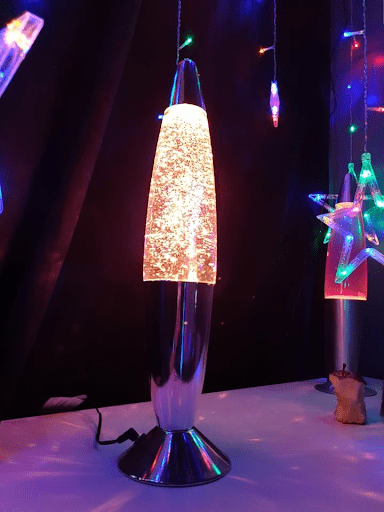
Lava lamps were all the rage in the 1990s, and there is a reason why: They are just so cool to look at! I would stare at my lava lamp for hours watching the bubbles move around and the light reflecting off each droplet. It brought a sense of relaxation over me, and it can have the same effect on your students. Bring back this oldie but goodie to your sensory room and watch your students get mesmerized!
Buy it: Lava Lamp – Lava Lite at Target; Lava Life Lamp at Walmart; Liquid Motion Bubbler for Kids at Amazon
Image: Noah’s Ark Childcare
7. Play in a sand or water table
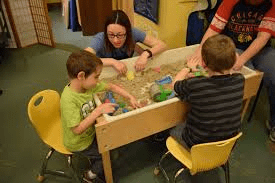
Sand tables are wonderful for children of all ages. They encourage students to engage and play all while strengthening their fine motor skills, cognitive skills, tactile experiences, and proprioception. Adding a sand (or water) table to your sensory room will allow your students to explore and can be an area where students work on communicating and sharing with one another.
Buy it: Step2 Naturally Playful Sand Table at Amazon; Word Formation Sand Tray at Oriental Trading
Image: Field Museum
8. Take a walk down a sensory path
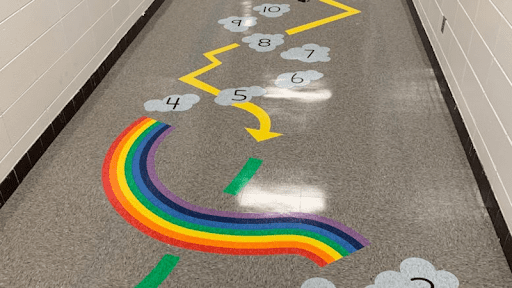
Children are wiggle-worms—it is part of their nature! Sensory paths are a wonderful resource in a sensory room or in other areas of your school. Place sensory paths in the hallway to encourage students to release energy in their simple movements (like walking in a line) around the school. When you have a student who needs a minute to let off some steam, have them venture down the sensory path. A quick few minutes will help them regroup and allow them to return to the classroom refreshed and ready to learn.
Buy it: School Floor Sensory Path at Etsy; Really Good Stuff EZ Stick Sensory Path for Hallways at Amazon
Image: Shelby County Reporter (Helena Elementary School)
9. Watch LED bubble tubes

There are many sensory room ideas that involve mood lights. LED bubble tubes satisfy the visual stimulation some students crave. Similar to a lava lamp, students watch the bubbles, highlighted by LED lights, move around the tube. These LED bubble tubes can be large or small in size, depending on your environment. These eye-catching beauties will not disappoint!
Buy it: Playlearn Sensory LED Bubble Tube at Amazon
Image: SplashLearn
10. Hold water beads
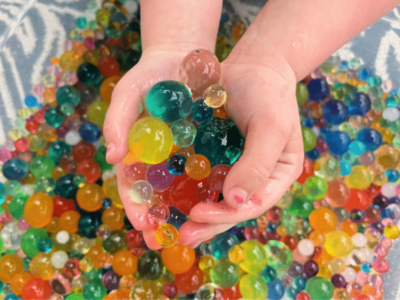
Have you ever been to a wedding and seen colorful beads filling the flower vases? Mesmerizing, aren’t they? Water beads are a great asset to your sensory room as they can fill a sensory bin for your students to explore. Students can dig through the beads to find objects, sort by color, or simply play with them in their hands. Water beads will hold students’ attention and distract them from their daily worries.
Buy it: Sensory Water Bead Bean Bags at Amazon; Water Beads by Creatology at Michaels
Image: Someone’s Mum
11. Jump on a crash pad
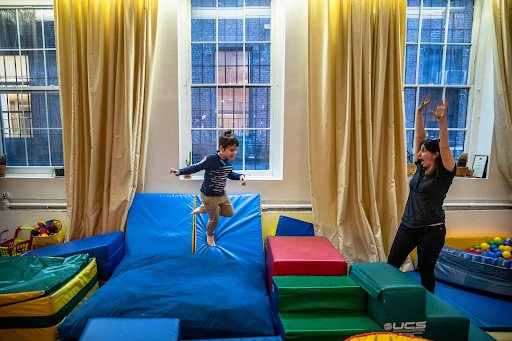
Instead of creating pillow forts for students to topple into, consider a crash pad! Crash pads are just that: a place for a students to jump and “crash” into. Some students may be doing this to let out energy or to reenact something they’ve seen. Other students are doing this to fulfill a sensory need. So let them jump! Let them run! Let them crash (safely, of course)!
Buy it: Milliard Deluxe Crash Pad at Amazon
Image: The New York Times
12. Jump on a trampoline
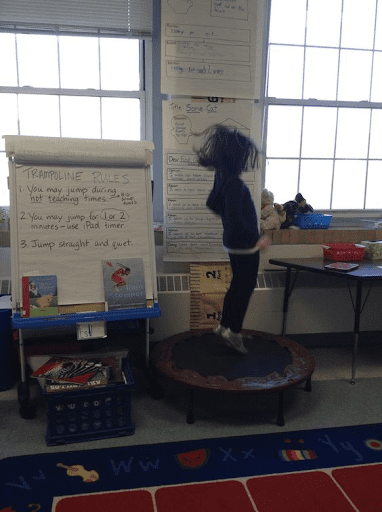
Students come to school with a variety of needs daily. Some kids may come to school having too much energy they need to let off. Other students simply need a physical sensory outlet. A trampoline is a great, cost-efficient tool to meet these student needs. It is the perfect addition to your sensory room.
Buy it: Costway Kids’ Trampoline w/Handrail at Target; Little Tikes 3-foot Trampoline at Walmart
Image: I’m 4 Students
13. Press on gel pads
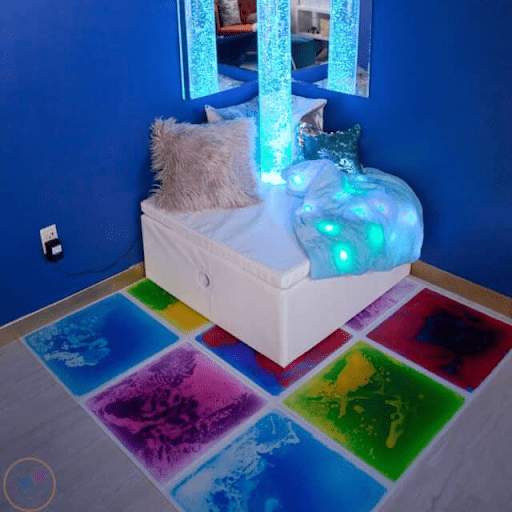
In need of more sensory room ideas and hands-on sensory items? Consider gel pads! They come in a variety of shapes and sizes depending on their intended usage. You can have students use these for sensory satisfaction while they push the pads and watch the gel move around. You can also incorporate academic learning by having students form letters, numbers, and shapes in the gel. It will be a student favorite in your room.
Buy it: Liquid Fusion Activeplay Centers at Amazon
Image: Your Kids Table
14. Lounge in a sensory pea pod
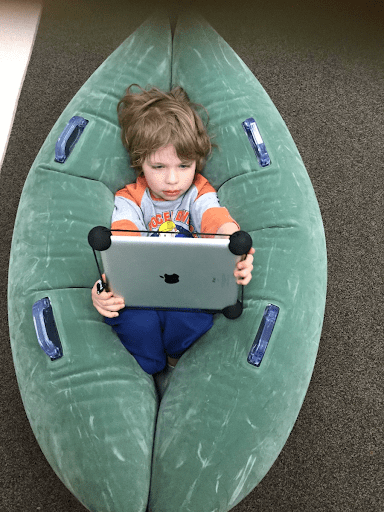
Deep-touch pressure provides a calming effect to the body. If you need some flexible seating ideas for your sensory room, try sensory pea pods—large cushions with a hole in the middle for students to sit in. They can relax, complete their learning, have conversations, etc., while sitting in the pea pod. This great addition to your sensory room allows students to unwind and regroup during the school day.
Buy it: Hakla Hug Autism Sensory Chair at Amazon
Image: Stephanie Di Fazio Twitter
15. Look in the mirror

Sensory rooms are intended to be a place where students can go to relax, let out their overstimulation, or have life-skills learning time. A simple yet wonderful tool you can add to your list of sensory room ideas is a mirror. Students can use the mirror to look at themselves, their bodies, and their facial features. Mirrors can also be used as a teaching tool to learn about emotions and expressions. A helpful (and inexpensive) find for your school’s sensory room.
Buy it: Mainstays Rectangle Door Mirror at Walmart; Handheld Mirrors at Dollar Tree
Image: Fun & Function
16. Build foam play structures
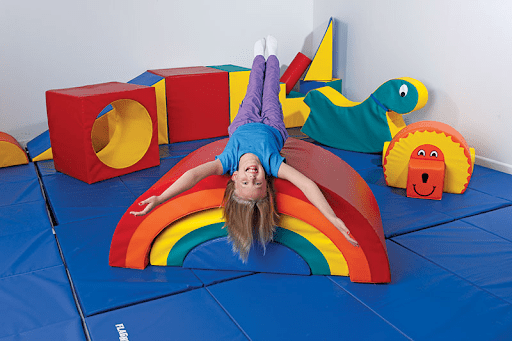
Students love to jump, crawl, lay, throw, and topple over objects. Purchase some foam play structures for students to do just that in your sensory room. Foam play structures come in a variety of sets, shapes, and colors. They are soft and safe for students to use and hard for them to destroy. These can get a bit pricey but will pay off in the long run.
Buy it: Softzone Foam Indoor Play Structure at Oriental Trading; Climb & Crawl Foam Activity Play Set at Amazon
Image: Abilities.com
17. Balance on a yoga ball
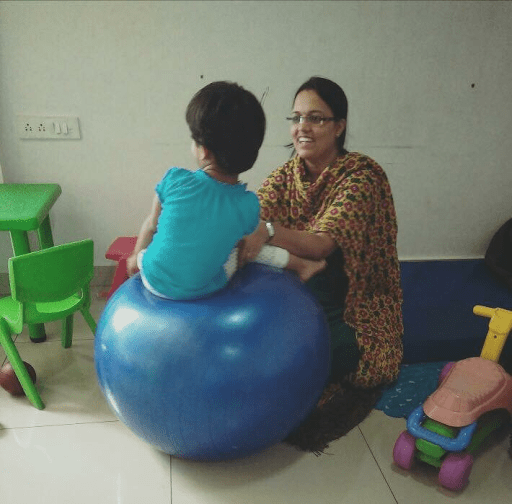
Occupational therapists use yoga balls to help people strengthen their balance and range of motion. Yoga balls can also be used in a sensory room to help students exercise their vestibular needs. Not only is it a fun tool to use, it will greatly benefit your students’ gross motor skills.
Buy it: Merrithew Kids’ Stability Ball at Target; Thick Yoga Ball Chair at Walmart
Image: Playstreet – Therapy Ball
18. Crawl through a tunnel

The ability to crawl is a gross motor skill milestone we look for with babies. As children get older, they need to exercise their gross motor skills in a variety of ways, and a tunnel is a great tool to use. Placing fun, colorful tunnels in the sensory room allows students to crawl and explore in their protected world. This is an affordable resource you can find at a variety of stores.
Buy it: Toy Time Kid’s Pop-Up Tunnel at Target; Spark Create Imagine Pop-up Tunnel at Walmart
Image: A Little Pinch of Perfect
19. Stick sensory decals on the wall
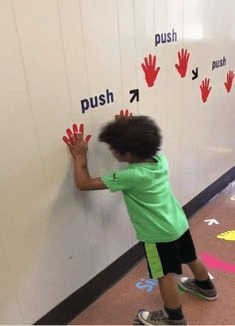
Sensory wall decals are similar to a sensory path. These vinyl decals can be placed on a wall (either in your sensory room or in the hallway) for students to use to exert their sensory need. Students follow the directions on the decal as they push, slide, jump to, or poke the provided decal. Students will have so much fun, they will not even realize this is a tool to aid their emotions!
Buy it: Lazy Breathing Wall Decal at Etsy; High-Five/Push Wall Decal at Etsy
Image: Filter Free Parents
20. Touch fiber-optic lights
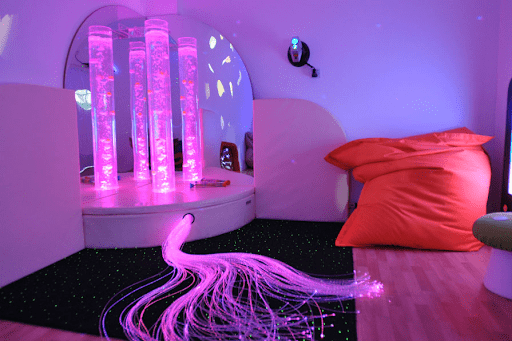
Students who typically visit the sensory room are curious and looking to discover new things. Lights tend to catch young students’ attention, and using fiber-optic lights is a great way for students to explore with lights in the sensory classroom. Not only are they fun to look at, they are safe for students to touch and use in their sensory play.
Buy it: LED Multicolor Changing Fiber Light at Amazon; Fiber Optic Curtain Light Kit at Amazon
Image: The Rompa Winslow Blog
21. Hang out in a ball pit
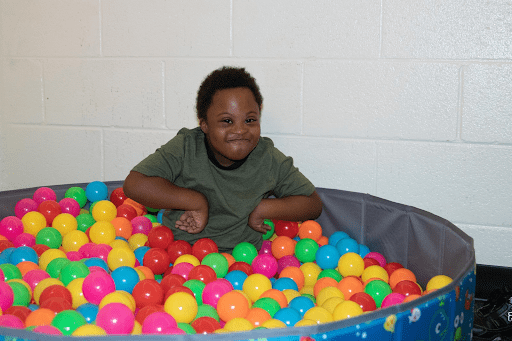
Ball pits are one of our favorite sensory room ideas. They are popular at children’s play venues because they provide a variety of learning benefits. Students can use their fine motor skills by picking up and throwing the balls and socialize with one another through play in a ball pit. They can learn about shapes and colors while exploring and have fun while doing it! The pressure of sitting in the ball pit can also bring comfort to your sensory-friendly students in the same way a weighted blanket can.
Buy it: Ball Pit Kit at Oriental Trading; Ball Pit with Balls Mini Playspace at Target
Image: Cobb Schools (Chalker Elementary School)
22. Explore textures
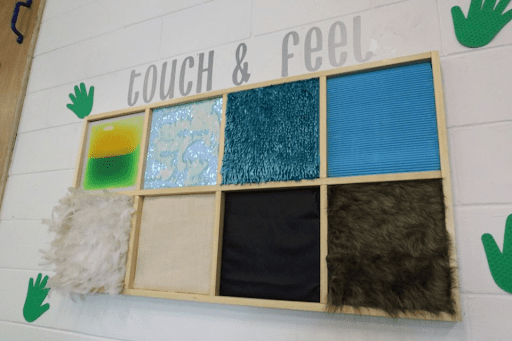
Exploring with the senses is good for both the body and mind. Sensory exploration helps build nerve connections and can assist a child in the development of both their fine and gross motor skills. Consider adding a touch-and-feel wall to your sensory room. Students can feel a variety of textures including soft, hard, smooth, bumpy, slimy, and furry surfaces.
Buy it: Playlearn Textured Floor Mat Puzzle at Oriental Trading
Image: Soo Today
23. Focus on light projections
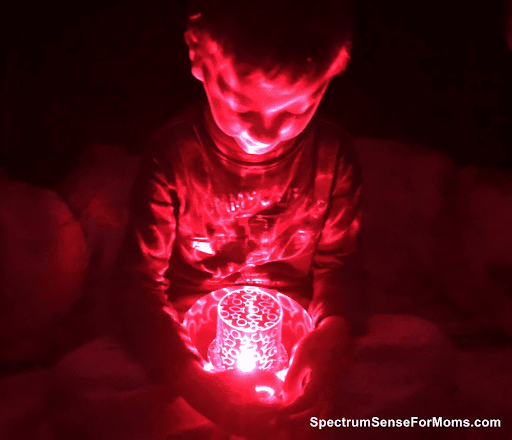
Most students that venture (or need to take an adventure) to the sensory room have a strong sense of curiosity. Let students explore this sense of curiosity with light projectors. Students can gaze at lights along the classroom ceiling or watch the lights as they move around the room. These will not only appeal to students but to teachers as well as this device can easily transform your sensory room into a calming world.
Buy it: Peroptimist Kids Night Light Projector at Walmart; LED Party Projector at Target
Image: Spectrum Sense for Moms
24. Cover up with a weighted blanket
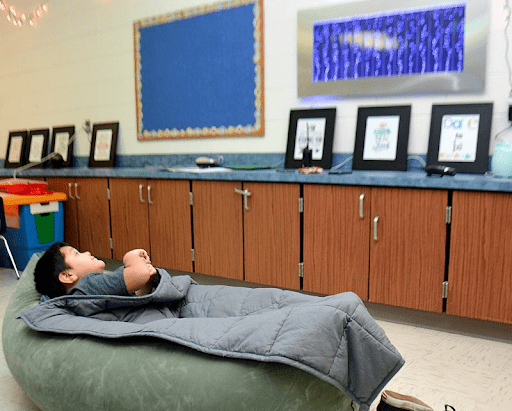
Weighted blankets have been used to bring comfort to both kids and adults with anxiety. As an adult, they have brought a sense of comfort over me when I start feeling overly stressed/upset. You can purchase 3- to 6-pound weighted blankets for your students to use in the sensory room at your school (keep in mind they should be a comfortable weight, not too heavy for children). Students can snuggle under a blanket to de-stress, look at a book, or simply relax.
Buy it: 6lb Waterproof Removable Cover Weighted Blanket at Target; Sivio Kids Weighted Blanket at Amazon
Image: Northwest Arkansas Democrat Gazette (Siloam Springs School)
25. Play on a padded floor
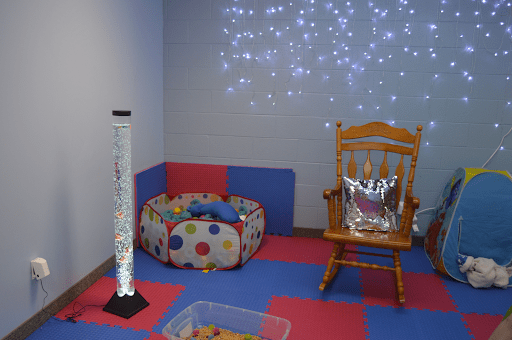
Consider having padded mats, cushions, or floors in your room to help students whose bodily movements are a bit intense or extreme. These padded mats can be spread across the whole room or only be positioned in areas where students could possibly get hurt. Purchasing these mats will be a sound investment for your sensory room.
Buy it: Stalwart Foam Mat Floor Tiles at Walmart; ProsourceFit Puzzle Exercise Mat at Amazon
Image: Courier Express
26. Snuggle with stuffed animals

Young children tend to enjoy stuffed animals. Cuddling a plush stuffed animal brings warmth and a sense of comfort to a child. Consider having stuffed animals in your sensory room for students to have access to if they need a hug, comfort, or just a furry friend.
Buy it: Bulk Mini Stuffed Animal Assortment at Oriental Trading; Fuzzy Friends Plush Animals at Dollar Tree
Image: Capcon Quiet Room
27. Sensory bottles
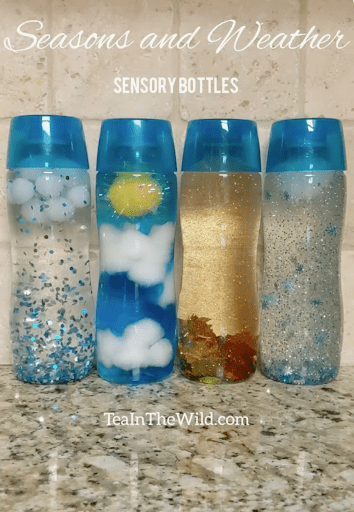
No list of sensory room ideas would be complete without classic sensory bottles. They can be modified for use by students of all needs and are popular as they can be filled with a variety of different materials to allow students to explore in a non-messy way. You can purchase pre-made sensory bottles (bottles for the seasons, weather, emotions, and more), or create your own sensory bottles for your students’ specific wants/needs.
Buy it: Express Your Feelings Sensory Bottles at Amazon; Tornado Spin & Watch Bottle at Amazon; Empty Plastic Juice Bottles at Amazon (to create your own sensory bottle)
Image: Tea in the Wild
28. Fiddle with fidgets

Though fidgets have become a new toy trend, consider their initial purpose and usage. Fidgets are tools intended to calm and relax oneself. Fidgets can come in a variety of shapes and sizes, from squishy balls, Pop-Its, and slime to squeeze beans, puzzles, and more. Use a tub that includes a variety of fidgets in your sensory room as a resource for your curious, upset, and wiggly little students.
Buy it: Fidget Toys Sensory Kit at Amazon; Stress Balls at Oriental Trading
Image: ADDitude: Inside the ADHD Mind
29. Wear noise-canceling earmuffs
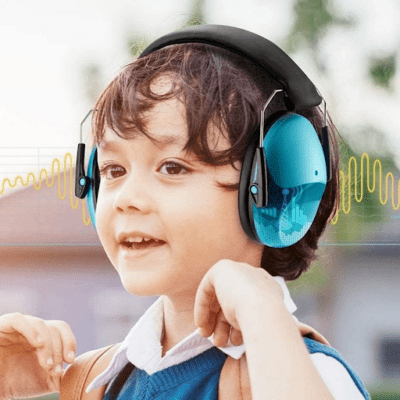
As adults, we have days that we want to tune out the world or have some peace and quiet. If you’re looking for sensory room ideas for little humans who want this grace too, try noise-canceling earmuffs. They help your students who are sensitive to noise and/or can provide added comfort to a student trying to de-stress and relax. These are essential to have on hand for students in any educational setting.
Buy it: Prohear Kids Ear Protection Noise-Canceling Headphones at Amazon; Amplim Hearing Protection Ear Muffs at Walmart
Image: Headphonesty
30. Chew on a sensory necklace
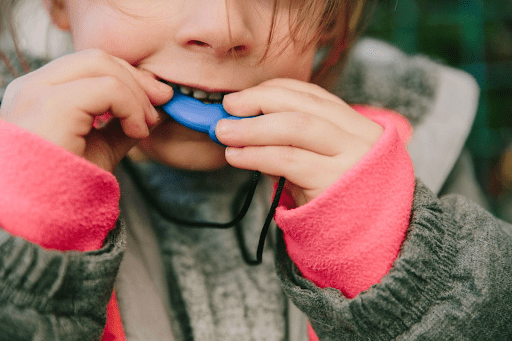
Have you ever had a student who constantly chews on pencils, erasers, or crayons? They may have an oral sensory need they are trying to satisfy. For some kids, chewing is a way to calm and de-stress. Instead of punishing this behavior, provide them with safe resources to satisfy this need. You can find a variety of chewable necklaces in cool shapes and designs for your students.
Buy it: Chew Necklaces at Amazon; Munchables Sensory Chew Necklaces at Etsy
Image: Kindercare
Have other sensory room ideas to share? Post them in the comments below!
For more resources like this, be sure to subscribe to our newsletters.
